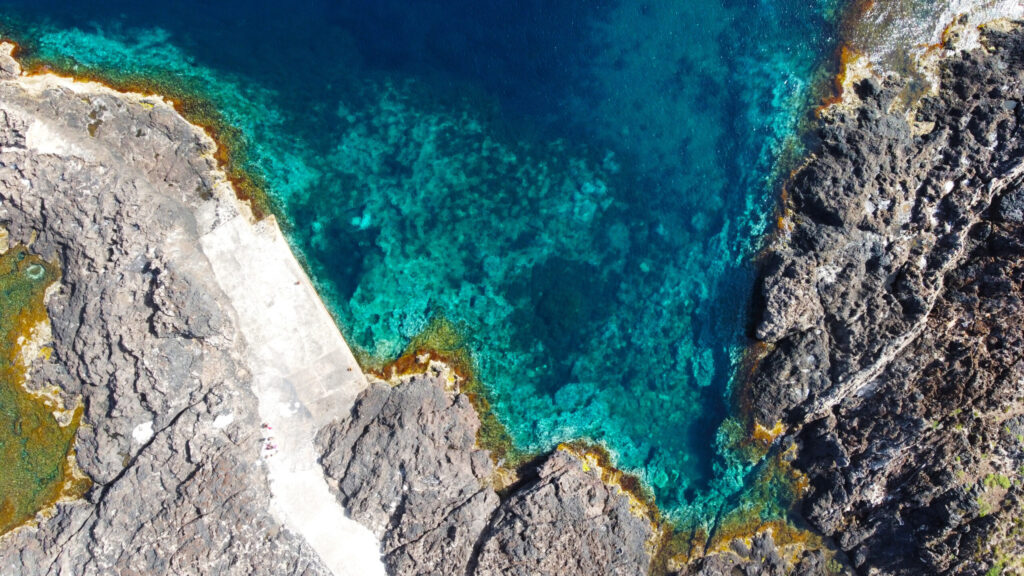Multimedia Experience – A.M.P. Sea Room
Virtually explore the seabeds of Ustica in the Marine Protected Area located in the historic center. With innovative viewers, discover underwater wonders and learn about sustainability and artisanal fishing.
Symbol
Blue Pin
Duration
1 hour
Suitable for
Adults Children and teenagers Families Schools
Description
This is a multimedia marine experience that takes place in one of the facilities of the Marine Protected Area, located in the central square of the old town hall.
Here, you’ll find a unique way to experience the sea of Italy’s first Marine Protected Area. Without getting directly into the water, but comfortably seated in a room, you can immerse yourself in the waters of Ustica and marvel at countless marine flora and fauna. Once you enter this tranquil blue room, just settle into one of the provided bean bags and put on the high-resolution Oculus headsets (immersive virtual reality viewers). A massive 8K projection screen and a Dolby Surround sound system will transport you into Ustica’s seabed in a fully immersive and thrilling multimedia journey.
Additionally, in the same space, you’ll learn about sustainable practices like artisanal fishing through informative panels. This is a place dedicated to scientific outreach, promotion, and protection of Ustica’s underwater heritage, where both adults and children can learn through fun—edutainment will be the guiding theme of this new “non-place.”
The new Environmental Education Center (CEA) will allow for scientific outreach starting with the youngest generations, teaching them about the sea and its wonders, artisanal fishing with its non-invasive techniques, maritime traditions through stories and anecdotes, and fishermen—the true guardians of the sea—as keepers of centuries-old traditions.
A high-quality innovation that can also be enjoyed in winter. Definitely a step forward in reducing seasonal tourism dependency.
Highlights
The pristine seabeds of Ustica, a destination for divers from around the world, were introduced to the general public through the International Underwater Activities Exhibition, which began in 1959 and has now reached its 64th edition.
This internationally renowned event earned Ustica the title of the world’s diving capital. Over the years, the prestigious “Golden Trident” award—equivalent to the Nobel Prize of underwater activities—has been given to around two hundred notable figures, including Jacques-Yves Cousteau, Walt Disney, Folco Quilici, Jacques Piccard, Enzo Maiorca, Jacques Mayol, as well as scientists and numerous researchers. Among its regular attendees were also many professionals, renowned artists, and TV hosts like Pippo Baudo, Mike Bongiorno, and Corrado Mantoni.
Originally organized by the E.P.T. (Provincial Tourism Board), the Exhibition used to run from May to September, featuring underwater fishing competitions alongside shows, conferences, underwater photography exhibitions, underwater archaeology, cinematography, underwater television, specialized publishing, sector-specific visual arts, and diving courses. It was a major attraction not only for diving enthusiasts, researchers, and scientists worldwide but also for countless tourists.
Today, if Ustica and its sea attract thousands of tourists, credit also goes to the natural conservation system implemented in harmony with the local residents, who are directly involved in environmental education efforts.
Its waters witnessed the creation of Italy’s first Marine Protected Area, officially established on November 12, 1986. The “Seabeds of Ustica” have been recognized as a Site of Community Importance under the Natura 2000 Network, the European Union’s primary tool for biodiversity conservation. The marine area is divided into three zones covering approximately sixteen thousand hectares of sea, plus over fourteen square kilometers of coastal land.
Zone A, the full reserve area, extends over sixty hectares – fifteen hundred meters in length by about two hundred meters in width – and includes the stretch of sea marked by the five yellow lighted buoys opposite Scogli Piatti, running from Cala Sidoti to Cala Santoro.
In this area, navigation, mooring, and stopping of any type of vessel are prohibited. Fishing activity, along with any other actions causing disturbance or alteration of the natural environmental characteristics, is forbidden.
In some coastal areas, even walking is prohibited due to the presence of the “trottoir” (a vermetid platform, literally translated as “sidewalk”) along the shores, formed by the cementation of two species of gastropod mollusks: Dendropoma cristatum and Vermetus triquetrus.
The importance of this biostructure lies in its ability to modify the ecological characteristics of rocky coasts, creating tidal pools that enhance the biodiversity of associated populations. For the reasons mentioned above, the Trottoir is protected by the Bern Convention. Swimming and snorkeling are only permitted at Cala Sidoti, Scogli Piatti, and Caletta (formerly Acquario).
Zone B, which also encompasses Zone A, covers approximately 8,000 hectares and extends up to three miles from the coast. It includes the northwestern side of the island, from Punta Cavazzi to Punta Omo Morto. In this area, the removal of any form of plant or animal life is prohibited. However, recreational boating and sport fishing with stationary or trolling lines are permitted, the latter only with prior authorization and exclusively for locals. Scuba fishing and trawling are strictly forbidden.
The partially restricted Zone C, equally extensive, instead comprises the southeastern slope of the island. In this zone, navigation and docking are permitted. Professional fishing is allowed for tourists only with prior authorization. All forms of sport fishing are permitted within legal limits; however, spearfishing and trawling are strictly prohibited. As for marine fauna, the seabeds of Ustica are home to numerous species, including: pink shrimp (Plesionika narval), dusky grouper (Epinephelus guaza), wreckfish (Polyprion americanum), Atlantic bluefin tuna (Thunnus thynnus), albacore (Thunnus alalunga), greater amberjack (Seriola dumerili), garfish (Belone belone), striped red mullet (Mullus surmuletus), common dentex (Dentex dentex), European barracuda (Sphyraena sphyraena), gilthead seabream (Sparus aurata), salema (Salpa salpa), saddled seabream (Oblada melanura), European squid (Loligo vulgaris), European flying squid (Ommastrephes sagittatus), spiny lobster (Palinurus elephas), European lobster (Homarus gammarus), and the Mediterranean false black coral (Gerardia savaglia).
Recommended clothing
Suitable for public premises
Important Notes
Unique multimedia tour of the island
Steps at the entrance
Itinerary Data
Recommended Period
from May to September
Time: From 10:00 AM to 10:00 PM

